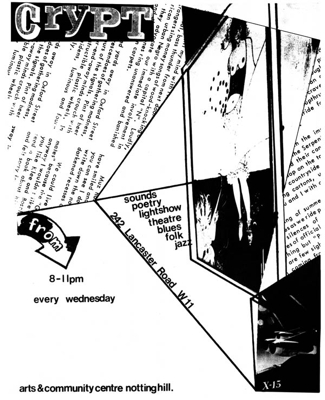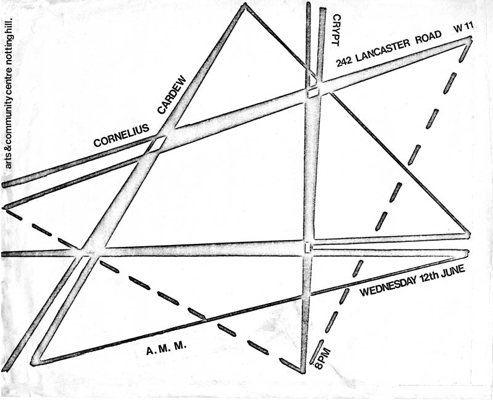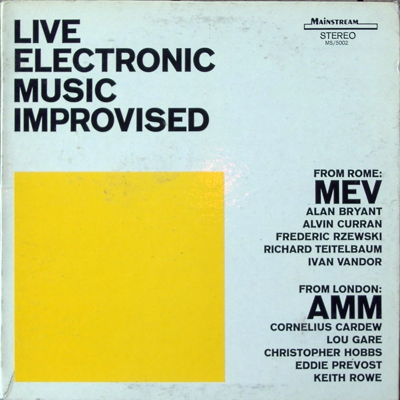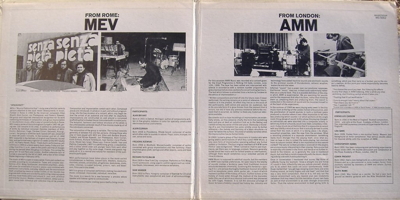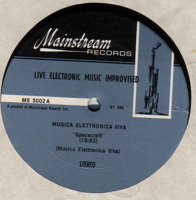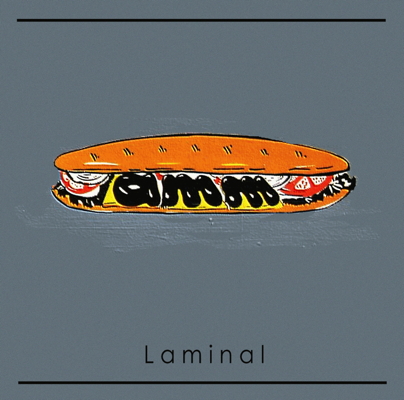> Studies > FAC-SIMILES
CORNELIUS CARDEW (AND FRIENDS)— AMM — The Scratch Orchestra —— Red Flame Proletarian Propaganda Team — People’s Liberation Music —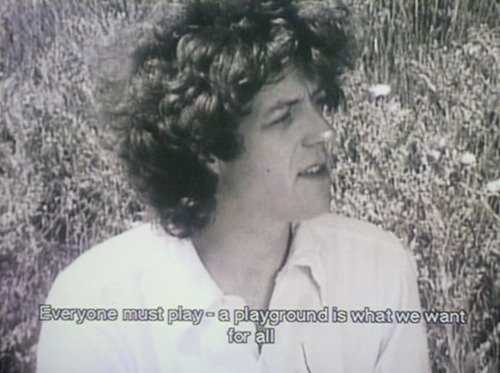
page 3 — 1966-AMMpage 1 (1958-1961) — page 2 (1961-1966) — page 4 (1968-1969) — page 5 (1969-1972) — page 6 (1972-1981)page 7 (list of works, references & concerts timeline) |
1966 FREE IMPROVISATION - AMM(Edit)
| Does group direction, or authority, depend on the strength of a leading personality, whose rise or fall is reflected in the projected image, or does the collation of a set of minds mean the development of another authority independent of all the members but consisting of all of them? An AMM performance has no beginning or ending. Sounds outside the performance are distinguished from it only by individual sensibility. The reason for playing is to find out what I want to play. Given a certain amount of experience, it is not difficult to assimilate any object. Every noise has a note. The past always seems intentional, but at the time it appears to be accidental. Playing in AMM sometimes produces a state where you feel sounds in a completely different way from usual. Seeing as if for the first time this reddy-brown object with all the strings going away from the left, a bow going across the strings on the right hand side and interwoven amongst the strings various little things, on top of that plastic lid, and just watch the sound happening. There is no guarantee that the ultimate realisations can exist. To play and to arrive at the state where you no longer need to play. AMM started itself. It was there a few minutes before we thought of it. Within the time span of a performance the nearness of sound beauty becomes laughingly obvious, the players merely indicators of what is there already. Mistakes in and towards AMM could be due to constant references to sets of standards. There is no certain knowledge, in relation to your development that the effort you are making at the time is the right effort. (Liner notes of AMMmusic LP, 1967) |
|
The thrust of Cardew's musical development, already evident in the indeterminate scores of the early sixties, was in precisely the opposite direction - towards an ethnic, spontaneous music making, which found its ideal expression between the years 1966 and 1971 when Cardew was a member of the improvisation group AMM. (John Tilbury - reference). Cornelius Cardew participated in a AMM concert at the Conway Hall in May 1966.
Cardew, however, was beginning to see in improvised music an opportunity to play in a kind of pure present, to identify oneself fully with the music. In 1966, he joined a group of former jazz musicians already in the process of shedding every trace of the jazz idiom from their playing, featured drummer Eddie Prévost, saxophonist Lou Gare, and guitarist Keith Rowe, all jazz musicians. Cellist Rohan de Saram and pianist John Tilbury played with the group occasionally as well. They were called AMM and – between them – they would set the blueprint for the British school of free improvisation (along with John Stevens’s Spontaneous Music Ensemble and the Sheffield group, Joseph Holbrooke, featuring Derek Bailey, Gavin Bryars, and Tony Oxley). — Read interview by Keith Rowe, about the birth of AMM AMM was formed in 1965. The AMM group was the vehicle for some of Europe’s most adventurous improvised music of the 1960’s. Using electronic and acoustic instruments AMM pushed the limits of sound and collective creativity. It is important to stress the collectivity of AMM and the projects that immediately followed it. This was music that was composed on the spot, with equal input from all participants. AMM, a later the Scratch Orchestra, was an experiment not just in musical improvisation but also in radical democracy. No AMM performance is ever planned; each is unique and spontaneous. The musicians vowed never to rehearse and never to discuss what they had played. Stefan Szczelkun, a visual artist who would later join Cardew in the Scratch Orchestra, described his experience of seeing an early AMM concert. “You went into this completely dark room and you were enveloped in this extraordinary wall of sound. There were no beats, no melody. It was quite loud, but subtle as well. For me, it was a total revelation. There was suddenly this complete freedom of sound which maybe I had dreamt of but never experienced.” AMM performances would last for hours without a break. No two gigs were ever the same. As Cardew’s friend, the musician John Tilbury, would write in his extensive biography of the composer, “when Cardew became part of AMM, the trajectory of his life changed, and the seeds of much of his later work, both musical and political, were sown during this period.” He was making more music than ever before; at the same time, he was putting ever fewer dots onto the traditional staves of manuscript paper. Eddie Prévost, percussionist, was a co-founder of AMM, and remains its only constant member. He comments on its ethos: "The only way we have any purchase on the world is by our own actions. And just the thought of the usual strategies for political and cultural response—applying the democratic process—in the face of the overwhelming odds of tradition and existing economic and political power is immobilising. Our activities must be closer to home, closer to our being. To borrow from William Blake: it is in the development of the “minute particulars” that we have real power. As musicians our power is in how we decide to create sound. How we place a sound next to another. How we chime with or divert a musical course in dialogue with others—while at the same time developing the structure, the nature and the dynamic of dialogue itself. As an audience too we must decide how we discern and positively support these practical efforts in music-making, and insist upon such aesthetic priorities. If these considerations begin to command our musical lives and even become the basis for musical appreciation and cultural critique, then the power of those who wish to do things to others is challenged by the determination of those who choose to do things with others." — In Eddie Prévost, "Minute Particulars - meanings in music making in the wake of hierarchical realignments and other essays", 2004) « [...} He who would do good to another must do it in minute particulars [...] » — (William Blake, In "Jerusalem") « AMM was always a radical, marginal, improvising group, owned by no one, free and responsible only to ourselves, » asserted Keith Rowe. « Our heroes were American artists David Tudor, Merce Cunningham, John Cage and Robert Rauschenberg, plus jazz performers like Cecil Taylor. ["Tomorrow is the Question" by Ornette Coleman was very important, and the Mingus stuff with Dolphy.] » « AMM was inspired by jazz, we learned its essential lessons and then moved on to create a more relevant activity for us given our time and condition. But there are others whom we engaged with as well: from Wagner we learned how to extend and stretch the material, from Mahler how to merge it, and from Rothko the process of oblique translation. » (Keith Rowe, BombMagazine). « AMM has never rehearsed. We meet up in airports. I don't rehearse. I never practise. I never take the guitar from the case. I only ever touch the guitar in the context of performances, unless I rewire the pick ups. One reason why AMM is different from free jazz is that, within free jazz, jazz, and much music in general, people conceive of sounds and (re)produce them in performances. AMM has always been about searching for the sound in the performance. I can honestly say that after forty years I still look at the guitar with absolute terror. I'm terrified of it. I've never got used to it. I still view it as something quite empty. » (Keith Rowe) « AMM came about through frustration, in a way. There was Eddie, Lou, me and Lawrence Sheaff, the bass player. Cardew came later. We were visual artists who also played musical instruments. We wanted to move on from what jazz was about. We were inspired by what black American musicians had done, but we found the jazz form terribly limiting. AMM was based on a philosophy whereas free jazz was based on performance of music. We knew what we wanted to do. Invent a music that would be ours - AMM music. Music that would fit into no category. We were outside the scene of improvised music. We still are. We've always been perceived as arrogant (maybe you have to be to say you're going to invent a new music), though personally I've never felt arrogant in my life. [...] One important difference between AMM and the other musicians is this question of repertoire. I don't think I know of any other group that set out to work without a repertoire, before AMM. That was a central part of what we were about, and that's a very very significant part of what we are about. Much more significant than people realise. A seismic shift in mentality in music. Other players got into playing freely, way before AMM [...]! Who knows when free playing started? You can imagine lute players in the 1500s getting drunk and doing improvisations for people in front of a log fire.. the noise, the clatter must have been enormous. You read absolutely incredible descriptions of that. I cannot believe that musicians back then didn't float off into free playing. The melisma in Monterverdi must derive from that. But it was all in the context of a repertoire. I think I've tried to live the whole of my musical life without a repertoire. » (Keith Rowe, interview 2001) « Steel rulers and ball bearings were the first thing I used, and coins, very English coins from the period with the serrated edge, » says the AMM guitarist. « Knives over the pickup was quite a breakthrough for me too, because it perfectly matched this kind of ‘Duchampian’ thing, and cubism too, which had already interested me in the sense that an object could have lots of different utilisations. » Effects, through dissonant, did not spring from anarchic impulse. He applied rigorous methods drawn from the avant-garde and visual arts. « We did not want a jazz group with soloist. The philosophical model to get around background/foreground was cubism, where Pablo Picasso or Georges Braque glued cigarette packets or newspaper onto canvas. They took the pot, flowers, apples, and cloth in the back. A democracy where the cloth was as important as the flower. In jazz, the soloist was the flower. The canvas was the drummer, piano and bass, the back line. How do you integrate these things ? My model was analytical cubism. You break all parts and reconstruct them on a democratic even base with no centre point or perspective, but held together by use of tone. And that was quite powerful. » « Laying the guitar flat came from Jackson Pollock, an abandonment of easel technique, with small brush and detail », Rowe explains. « When you give that up what you’re given in its place a horizontal canvas you can work on top of and use gravity. If I take a utilitarian object and call it art, it becomes art. By changing context, I change culture. I change the way you look at it. I liked the idea that thing you took and called art had an ambiguous feeling. If you took the same object, I could not tell the difference between your object and mine, because they look the same. I liked taking a knife or metal object I knew well, putting it in the guitar strings and hitting it. I was fascinated by, ‘What do you hear ?’. Do you hear Keith Rowe playing guitar ? do you hear a guitar, or a knife ? I was getting away from ego-driven music. I was interested in developing an ambiguous anti-technique-driven music. Soon you develop an eye and know what to pick up for the guitar. » Lawrence Sheaff remembers : « All the surface possibilities had been lait out. In painting, in music, what was left ? Only subdivisions of the subdivisions. If you got that picture, where to go from there ? ‘In’ was where to go. ‘In’ not ‘out’. For me AMM was a way to go ‘in’: to cut beneath the surface of things. For me, a great, silent whisper of a question was hanging behind every performance, ‘Where does it all come from ?’ » Keith Rowe’s own search, although equally philosophical, was more informed by pragmatic responses to material problems. « It was a straightforward contradiction between my day life and my night life, » he explains. « When I was studying at art school during the day, the artistic agenda was, who are you, what do you have to say, and was about developing your language. In the evenings we’d play jazz where I was just imitating Americans. Well, that’s just a basic contradiction - what I was doing on the canvas was contrary to what I was doing on the guitar. On the guitar I was not finding my own language. I was basically hijacking someone else’s language like Jim Hall or Wes Montgomery and emulating what they did. In the world of painting you don’t have permission to paint other people’s painting. You only have permission to do your own work, whereas in the world of jazz you could do someone else’s work. You could just rip off Coltrane, and play just like Coltrane - and that was fine. There was nothing wrong in doing that. I just didn’t like that relationship. I wanted to develop my own language. So I took this instrument and looked at it more like an art project of what can I do with this, rather than coming with a whole load of baggage about what it is you do with it. And I think I very simply just applied the agenda of painting to the guitar. But what does that actually mean in practice ? For the Americans to develop an American school of painting, they somehow had to ditch or lose European easel painting techniques. They had to make a break with the past. What did that possibly mean if you were a jazz guitar player ? […] I thought if I did that (laying things on the floor like Pollock) with a guitar, then I would just lose all those techniques, because they would be physically impossible to do. So if it meant laying it on the table, I would lay it on the table. » « In the AMM we've always worked much more like painters. That means we're able to concern ourselves with aspects of life that I don't ordinarily understand. Maybe composers or piano players of the highest order can concern themselves with these aspects. [...] The start of AMM was quite a complex chemistry of ideas, ideas deriving from Gurdjieff, Taoism, Buddhism. I studied under a Buddhist monk called Sangharakshita, I studied form, perception, meditation. What I wanted to be able to do was look at something and understand it, or to be able to understand the relation, the tension between these two things (searches around for objects on the café table), between the corner of this [ashtray] and that round thing [the back of the chair].. I wanted to be able to walk into a space and immediately comprehend what the space was about. To be able to talk to you now and have part of my brain listening to what that coffee machine is doing or what that person is saying over there.. Part of Taoism was being able to do the right thing at the right time. You develop a sense of what to do. The classic example is you're walking down a street and stop to tie up your shoelace just as a brick falls off the building and lands where you would have been. Cardew was very strong on that; he would take students on a walk down the road and just have a running dialogue with them, analysing the street, the architecture, the verticals, the horizontals, the way the wind or light affects the colour of a building. I believe the use of the radio is something like that. » (Keith Rowe, interview 2001) Rowe talked about some AMM recordings being closer to 3 accompanists, accompanying each other, without kind of soloistic mentality. « If you have three or four people doing that simultaneously, it does get full and unnatural. I think most of us in those circumstances would draw back for a few moments. Partly because you’re not helping the situation continuing what you’re doing. But also maybe [..] that the person feels at that point the freedom to do something very soloistic. Being sensitive to that is not a bad thing, because it gives a dynamic to the overall picture of the music when someone does something very strong. […] In fact, it’s a skill to have four or five simultaneous possibilities and you’re only actually utilizing one of them, and you have something in the background that you can bring out straight away. For me, I would never try to react in that sense. I have the capability of reacting in that sense, but I much prefer having a schema you are running through, but a schema that has an ambiguity and open-endedness which will automatically accept almost any other activity along side it. […] You could be adjusting the equalization or maybe the volume, you could push it or make it more or less transparent, to make it work in a totality. Because obviously in the end you are always working for the totality of what is happening rather than what you are doing. And it’s much better in a way to understate what you are doing. Maybe it’s better to be doing something not so brilliant but adding to the whole in a way which makes it work. […] I would say one of the things that always needs to be avoided in music is affectation. […] A performance is a collaboration between everyone who is there and the room itself, the quality of the room, the expectations of the people and their actual concentration; it seems to be tangible. […] In a sense, I’ve always considered what I do on the guitar as an act of painting. At the very least the process of painting. I think in the world of music generally speaking, originality is not something on top of the list. If you go to conservatory, originality is not what music is about. Not a particularly good idea, I think. In rock and roll you have a little notion of originality, you try to find the new sound, but there is also a lot of copying, a lot of product. But in the music we make, there is much more a notion of originality. Finding your own voice is a major part, and for a lot of people, the most important part. So I think I had that idea right from the start, certainly in the early to mid ‘60s. I thought my primary responsibility was to find a new angle for the instrument, like in painting, searching for a new angle. That’s what you do in art school. I’ve always considered what I’ve done is painting, and for me it is the perfect painting, there is no commodity, it can’t be traded like a painting can. Improvisation was a perfect way of making a painting, so I could be concerned with all the issues of painting. When you go to hear a Haydn string quartet, there are no surprises, are there? In terms of newness. People listen for the exquisite exposition of the quartet. They have a Haydn-esque quality to them, they’re always Haydn. Same with Schubert. Maybe we have in our maturity, as a group of people working on this music, as a community, what we have to think about this issue of newness, of freshness, and maybe there is also room for repeating something, what you’re getting involved in is the exquisite nature of this exposition rather than the newness. It still seems to be in the air where everyone needs to be creating new stuff all the time. I have no dogmatic stand on this, I’m not thumping the table, but it does seem to me that we should be thinking about it. » (Keith Rowe, interview 2001) « AMM is a leaderless group, certainly, but the politics is within the counterpoint. In the AMM there are probably hundreds of categories of counterpoint which are highly political. One of the many counterpoints in the AMM is the difference in physicality; clearly Eddie is the most physical, John is in between, and I'm the least physical. There's a level of gearing. As you know, with amplified instruments it's very different. I can make a shatteringly loud sound by a move which is much less than a millimetre. That type of gearing produces a very different type of physicality. » (Keith Rowe) The notion of there being no division between performers and audience was particularly suited to AMM, for whom all sounds constituted part of the piece being performed (and the room, its responses, its reactions, where people and musicians perform), whether they originated in the group or the audience. Cornelius Cardew — who played piano, cello and transistor radio — though he rarely, if ever, touched the notes of the piano, preferring to pluck the strings or tap on the frame — wrote ‘An AMM performance has no beginning of ending. Sounds outside the performance are distinguished from it only by individual sensibility.’ About Cornelius Cardew and AMM, John Tilbury relates : — (reference)
In AMM Cardew encountered, perhaps for the first time, musicians as uncompromising as himself, who had already entered the uncharted territory of improvisation and who would risk all in the making of each performance. A short entry in Cardew's diary for 1965 reads like a prophetic description of AMM music:
Music is a vagrant; it has no fixed abode. It's a menace to society. It needs cleaning up. The impossibility of abolishing music. Its omnipresence. Its uncatchability. Perhaps after all we have to step down and let music pursue its own course. — [Diary entry, 25 February 1965.] The importance of AMM for Cardew cannot be overestimated, as he acknowledged himself. Mutual understanding within the group reached a depth that he had never experienced in concert-hall music. The four original members of AMM were Keith Rowe, Eddie Prévost, Lou Gare, and Lawrence Sheaff [even if the AMM three letters well corresponds to three members : "We always thought that AMM should be three elements. If it's two elements, it's not AMM. In AMM philosophy three is four: the three players plus the group itself makes four." (Keith Rowe], all of whom came from a jazz background. They met regularly for sessions that generally lasted about two hours, with no formal breaks or interruptions, though there would sometimes occur extended periods of near silence. In an essay entitled 'Towards an Ethic of Improvisation' (1971) Cardew wrote: It is not the exclusive privilege of music to have a history - sound has history too. Industry and modern technology have added machine sounds and electronic sounds to the primeval sounds of thunderstorm, volcanic eruption, avalanche and tidal wave. It is to the 'history of sound' that AMM tries to contribute something. 'Informal' sound has a power over our emotional responses that 'formal' music does not, in that it acts subliminally rather than on a cultural level. This is a possible definition of the area in which AMM is experimental. We are searching for sounds and for responses that attach to them, rather than thinking them up, preparing them and producing them. The search is conducted in the medium of sound and the musician himself is at the heart of the experiment. — [Treatise Handbook, p. xviii] It was the humanising component of spontaneity in improvised music, which finds expression in the creative dialogue between musicians at the point of music making, that Cardew valued so highly. In AMM he found the embodiment of his ideas and feelings about music and freedom taken a stage further. On the relationship between Treatise and AMM he wrote in 1970: I now regard Treatise as a transition between my earlier preoccupation with problems of musical notation and my present concerns - improvisation and a musical life. Joining AMM was the turning point, both in the composition of Treatise and in everything I had thought about music up to then. — [From the introduction to a BBC broadcast of Treatise on 8 February 1970.] Playing with AMM enabled him to feel at home with the discipline that freedom can engender. Michael Nyman, in his book Experimental Music (1974), quotes Cardew's observation that self-discipline is the essential prerequisite for improvisation. Discipline is not to be seen as the ability to conform to a rigid rule structure, but as the ability to work collectively with other people in a harmonious and fruitful way. Integrity, self-reliance, initiative, to be articulate (say, on an instrument) in a natural, direct way; these are the qualities necessary for improvisation. — (cited by Julian Cowley) The latter part of the sixties and the early seventies parallel the immediately preceding period: Treatise and AMM, the related dominant preoccupations of the earlier period, are matched in the later one by two mutually determining activities - The Great Learning and the Scratch Orchestra. Lou Gare wrote the following ‘Subjective view of an AMM session’. It could be about one evening in particular, or it might be a random assortment of impressions. I arrive at the place, probably we have played there in previous weeks. Mostly we play once a week. The place is familiar then. Some or all of the other players are there. We chat a bit, set up equipment, tinker with things. Small sounds go on. The playing increases as we get involved in listening, searching, trying to perfect a sound, an action. The lights go out, or sometimes stay on but usually very low - almost dark. In the dark it is like having your eyes shut. All the sounds seems to go on inside. The sudden shocks of loud noise jolt one into alertness. The energy flows through the body. I think - a sound isn’t good - it doesn't fit - we’ve heard it before - but all the time I’m playing. And then something happens and I’m listening very closely - it’s beautiful and sharp and falls away, everyone is maintaining it, a slight change comes in, it alters, breaks down picks up again. It makes me laugh - I work hard - I can’t go on - it’s too difficult, why don’t they stop - but I play all the same. Just for an instant, or slightly more I’m right on the brink so to speak. It is good just to listen. I don’t know what to do. Keith is playing fantastically tonight. Why is Eddie laying on the floor? I can’t hear Cor. Why doesn't Christopher turn that thing off whatever it is? I shall go deaf if this noise goes on much longer. Why doesn’t someone turn the lights on - I hope they don’t, don’t stop. I can’t bear it. One is tossed this way and that - and I don’t move. It would be nice to play in this. It is very quiet. I must have been sitting here a long time, my ankle hurts. The silence goes on for what seems like a long time. The lights come on. Cor is still playing the cello. There are one or two or more people in the room as well. It seems as though I can’t listen - it has come to me. We chat a bit, make arrangements, discuss business, say goodbye. — Lou Gare c.1970 |
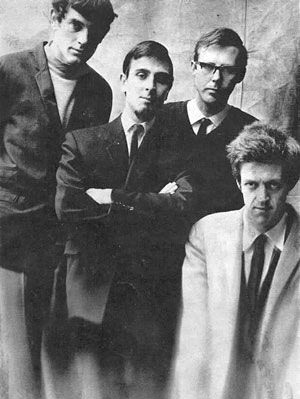 AMM - Lou Gare, Eddie Prévost, Keith Rowe - with Cornelius Cardew. 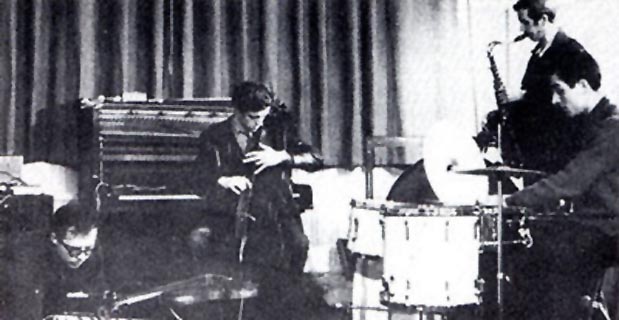 AMM (Keith Rowe, Cornelius Cardew, Lou Gare, Eddie Prevost), c. 1968 [LARGE VIEW] 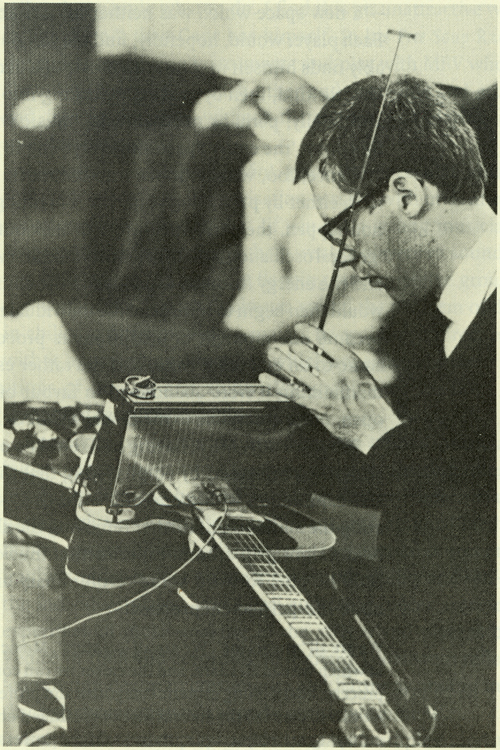 AMM - Keith Rowe Cornelius Cardew on AMM (liner notes of the LP The Crypt) « Written compositions are fired off into the future; even if never performed, the writing remains as a point of reference. Improvisation is in the present, its effect may live on in the souls of the participants, both active and passive (i.e., audience), but in its concrete form it is gone forever from the moment that it occurs, nor did it have any previous existence before the moment that it occurred, so neither is there any historical reference available… You choose the sound you hear. But listening for effects is only first steps in AMM listening. After a while you stop skimming, start tracking, and go where it takes you. Documents such as tape recordings of improvisation are essentially empty, as they preserve chiefly the form that something took and give at best an indistinct hint as to the feeling and cannot convey any sense of time and place. Obviously a recording of a jazz improvisation has some validity since its formal reference – the melody and harmony of a basic structure – is never far below the surface. This kind of validity vanishes when the improvisation has no formal limits. In 1965 I joined a group of four musicians in London who were giving weekly performances of what they called AMM Music, a very pure form of improvisation operating without any formal system or limitation. The four original members of AMM came from a “jazz background.” When I joined in I had no jazz experience, yet there was no language problem. Sessions generally lasted about two hours with no formal breaks or interruptions, although there would sometimes occur extended periods of close to silence. AMM Music is supposed to admit all sounds, but the members of AMM have marked preferences. An open-ness to the totality of sounds implies a ten- dency away from traditional musical structures towards informality. Governing this tendency – reining it in – are various thoroughly traditional musical struc- tures such as saxophone, piano, violin, guitar, etc., in each of which reposes a portion of the history of music. Further echoes of the history of music enter through the medium of the transistor radio (the use of which as a musical instrument was pioneered by John Cage). However, it is not the exclusive privilege of music to have a history – sound has history too. Industry and technology have added machine sounds and electronic sounds to the primeval sounds of thunderstorm, volcanic eruption, avalanche and tidal wave. Informal "sound" has a power over our emotional responses that formal "music" does not, in that it acts subliminally rather than on a cultural level. This is a possible definition of the area in which AMM is experimental. We are searching for sounds and for responses that attach to them, rather than thinking them up, preparing them and producing them. The search is conducted in the medium of sound and the musician himself is at the heart of the experiment. In the summer of 1966 we were playing every week in the tiny music room at the top of the London School of Economics, and the proliferation of sound sources in such a confined space produced a situation where it was often impossible to tell who was producing which sounds – or which portions of the single room-filling deluge of sound. [Alternate version] : In 1966, I and another member of the group invested the proceeds of a recording in a second amplifier system to balance the volume of sound produced by the electric guitar. At that period we were playing every week in the music room of the London School of Economics - a very small room barely able to accommodate our equipment. With the new equipment we began to explore the range of small sounds made available by using contact microphones on all kinds of materials - glass, metal, wood, etc. - and a variety of gadgets from drumsticks to battery operated cocktail mixers. At the same time the percussionist was expanding in the direction of pitched instruments such as xylophone and concertina, and the saxophonist began to double on violin and flute as well as a stringed instrument of his own design. In addition, two cellos were wired to the new equipment and the guitarist was developing a predilection for coffee tins and cans of all kinds. In this phase the playing changed: as individuals we were absorbed into a composite activity in which any kind of virtuosity would have been completely irrelevant. It also struck me at that time that it is impossible to record with any fidelity a kind of music that is actually derived in some sense from the room in which it is taking place – its shape, acoustical properties, even the view from the window. What a recording produces is a separate phenomenon, something really much stranger than the playing itself, since what you hear on tape or disc is indeed the same playing, but divorced from its natural context. What is the importance of this natural context? The natural context provides a score which the players are unconsciously interpreting in their playing. Not a score that is explicitly articulated in the music and hence of no further interest to the listener, as is generally the case in traditional music, but one that co-exists inseparably with the music, standing side by side with it and sustaining it. Once in conversation I mentioned that scores like those of La Monte Young (for example: ‘Draw a straight line and follow it’) could in their inflexibility take you outside yourself, stretch you to an extent that could not occur spontaneously. Keith Rowe replied that “you get legs dangling down there and arms floating around, so many fingers and one head” and that that was a very strict composition. And so it is; not only can the natural environment carry you beyond your own limitations (whatever that may mean) but the realization of your own body as part of that environment is an even stronger dissociative factor. Thus the natural environment is itself giving birth to something, which you then carry as a burden; you’re the music’s medium. At this point your moral responsibility becomes hard to define. “You choose the sound you hear. But listening for effects is only first steps in AMM listening. After a while you stop skimming, start tracking, and go where it takes you.” “Trusting that it’s all worth while.” “Funnily enough I don’t worry about that aspect.” “That means you do trust it.” “Yes, I suppose I do.” (Excerpt from a dialogue on AMM by David Sladen) — (Cornelius Cardew, while on an American lecture tour in November 1967, and in liner notes of the « Live Electronic Music Improvised) LP. — (And also : in "Towards an Ethic of Improvisation", Cornelius Cardew, from "Treatise Handbook," 1971, Edition Peters)
Miscelleaneous : AMM ?
Miscelleaneous : AMM and the London (Spontaneous) Underground, 1966
CONCERT AMM with Cornelius Cardew and Christopher Hobbs, The Crypt, Notting Hill Gate, London, June 12th, 1968 Follow Keith Rowe's interviews : (selection)
|
| (To order the below recordings) |
1967 AMMMUSIC(Edit)
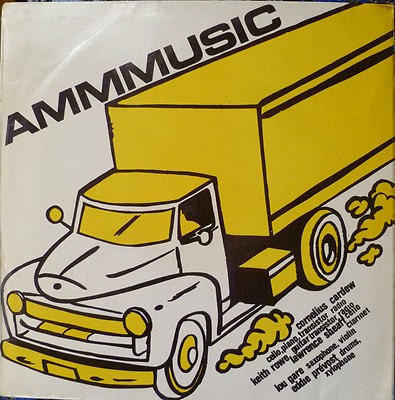 | 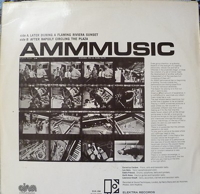 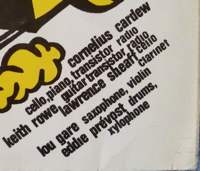 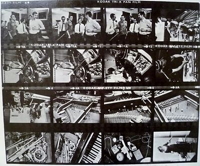 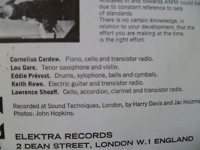 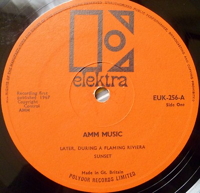 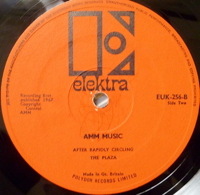 AMM MUSIC - LP Elektra Records, U.K. 1967 AMM Cornelius Cardew, Lou Gare, Eddie Prévost, Keith Rowe, Lawrence Sheaff Recorded on the 8th and 27th June 1966 at Sound Techniques. — Source : . |
VIDEO
AMM - After Rapidly Circling The Plaza (in two parts)
Recorded on the 8th and 27th June 1966 at Sound Techniques.
VIDEO
AMM - Ailantus Glandulosa
Recorded on the 8th and 27th June 1966 at Sound Techniques.
1967 - The Tiger's Mind(Edit)
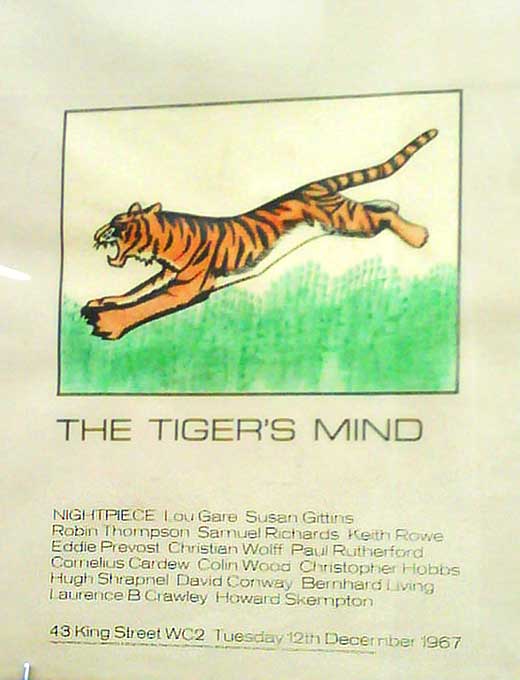 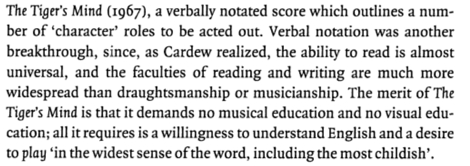 (Michael Nyman, in "Experimental Music: Cage and Beyond (Music in the Twentieth Century)", 1974) |
Good improvisation is never really free : experienced players will collect a repertoire of sounds and responses to anticipated contributions by others. The amount of freedom allowed varies with the style of improvisation. Trad-jazz improvisation is limited to such an extent in terms of harmony and the role of each player that it acts as an unwritten score (also called a ‘head chart’). Other improvisation, no matter how free, has limitations of stylistics built up by taste. Freedom can be overwhelming, especially to an inexperienced player who has not developed a repertoire of improvisational gambits common to experienced players (In this sense, members of AMM and other experienced improvisers considered them to be compositions) (see also intuitive music by Hugh Davies and Gentle Fire, after Stockhausen). This does not mean that interpretation of indeterminate elements in a written score should be confused with free improvisation (that is, the scoreless music played in Britain and the US in jazz and art music since the 1960s). [...] The experience of interpreting indeterminate music and of creating free improvisation is, for those who have worked seriously in both, a very different experience. In the first, one is working with and for - or against - the score; in the latter, one is working with and for - and against - one self and each other. The experience of improvisation for the experienced indeterminate performer is like the first performance of a high-wire act without a net : for once, there is no authority to which one can appeal or, in cases in which things go wrong, whom one can blame.
Cardew first attempted to impose a limitation onto improvisation in his AMM piece The Tiger’s Mind. This piece consists of two texts : a Daypiece and a Nightpiece. […] Aside from a reference to William Blake (’The Tyger’, which begins, ’Tyger, tyger, burning bright’), both pieces form a kind of mnemonic to indicate interaction between six improvisers or improvising groups : Amy, the tiger, the tree, wind, the circle, and the mind. Each role has assigned to it a kind of improvising personally of strengths and weakness in regard to the other roles, in a manner not dissimilar to the strengths and weaknesses to each role in the game of rock-paper-scissors. A player who assumed the role of Amy would therefore react more readily to the player assuming the role of the tiger. He or she would engage with those situated in physical proximity and would avoid playing with the person assuming the role of the tree when the player assuming the role of the wind was prominent. Cardew envisaged a learning period in which each of the six roles would be assigned to each of six musicians who would interact according to the plot of the two pieces. As players understood the interaction of the characters more clearly, they were allowed to assign their own roles in secret, so that a player who wished to play the circle, say, would assign roles to the others without their knowledge, making one wind, another the mind, and acting to their improvisations accordingly. Further adjustments to the story could be made as players became comfortable, and more than one player could assume a role (although not with knowledge more than one Amy). Mechanical and inanimate objects could be assigned roles in cases where fewer than six players were available. — (see also : characters in Applied Cryptography). In its use as a kind of training ground for improvisation and as a spur for improvisation, The Tiger’s Mind can be considered to be a trial run for the Improvisation Rites as defined in The Scratch Orchestra : a Draft Constitution (Cornelius Cardew, In The Musical Times, Vol. 110, No. 1516, 125th Anniversary Issue. (Jun., 1969), pp. 617 and 619) (see next page). It is also this limitation and educative feature of ‘’The Tiger’s Mind’’ which made it unpopular with the members of AMM when Cardew first wrote it. — (Virginia Anderson, Aspects of British Experimental Music as a Separate Art-Music Culture, Ph.D. thesis in Musicology, Royal Holloway College, University of London, January 2004) — (see also : more info about Cardew and William Blake). |
First published in The Musical Times Vol.108, No1492 (June 1967), pp527-530.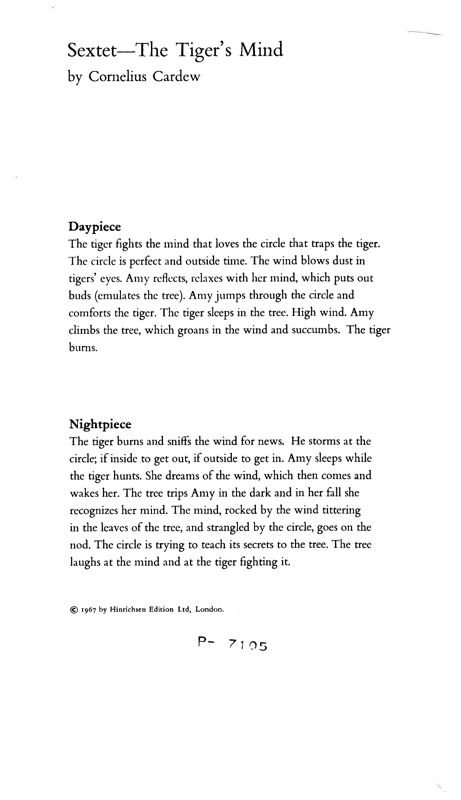 |  | |||||||||||||||||
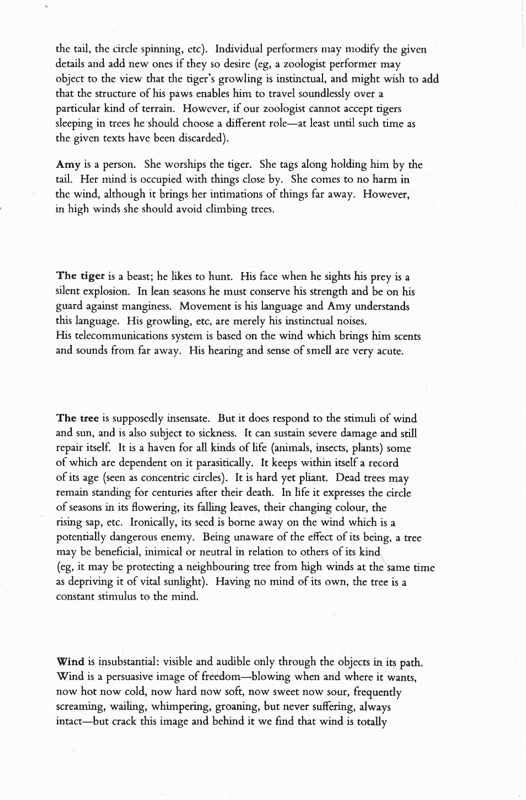 | 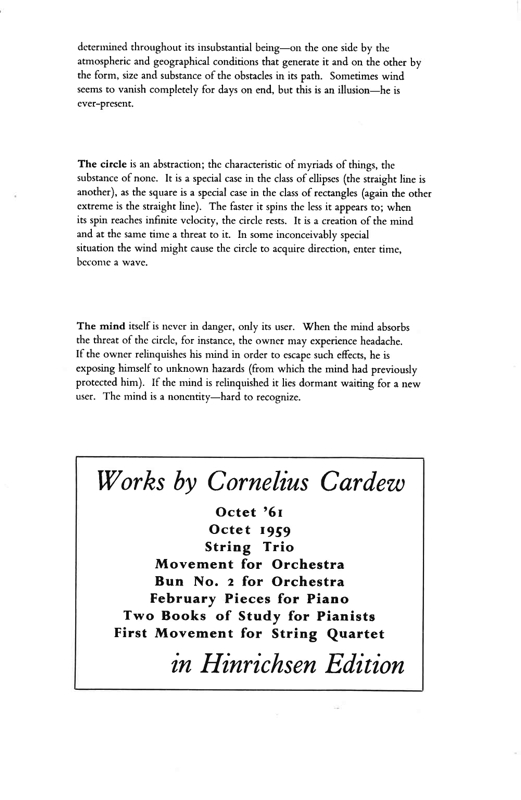 [Download the score] |
1968 (1970)(Edit)
1968 (1980)(Edit)
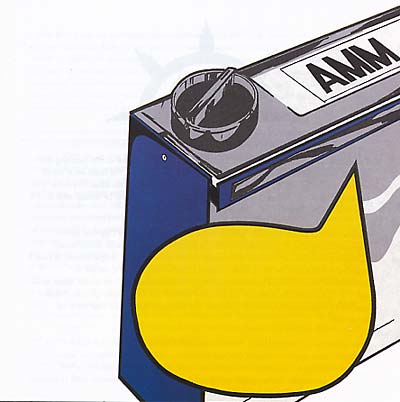 | 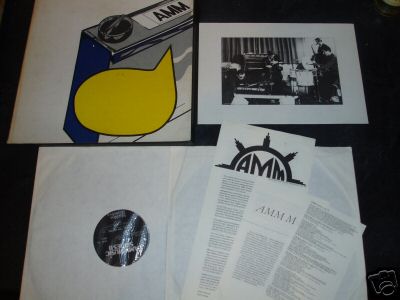 AMM THE CRYPT 12th June 1968 - LP Matchless Recordings, 1980 AMM Christopher Hobbs, Cornelius Cardew, Eddie Prévost, Keith Rowe, Lou Gare recorded at a concert given for the Crypt Programme in Notting Hill Gate, London, June 12th, 1968. — Source : . |
VIDEO
AMM - Neither Bill nor Axe would Shorten its Existence
Recorded at the Crypt, Lancaster Road, London W11, 12th June 1968.
1969 (1996)(Edit)
1971(Edit)
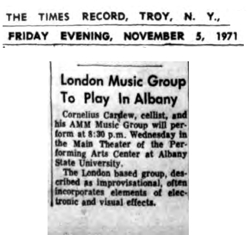 | London Music Group To Play in Albany — Cornelius Cardew, cellist, and his AMM Music Group will perform at 8:30 p.m. Wednesday in the Main Theater of the Performing Arts Center at Albany State University. The London based group, described as improvisational, often incorporates elements of electronic and visual effects. [Source : The Times Record, Troy NY, Friday Evening, November 5, 1971, p.22] [Source] |
 AMM (w/ John Tilbury) |
AMM Timeline(Edit)
by Hatta, Feb. 2010.
with all explanations and descriptions here
accompanied by AMM concerts" list.
|
Proto-AMM
AMM
AMM: double duos
AMM II
AMM
AMM III
AMM
AMM IV
References
|
